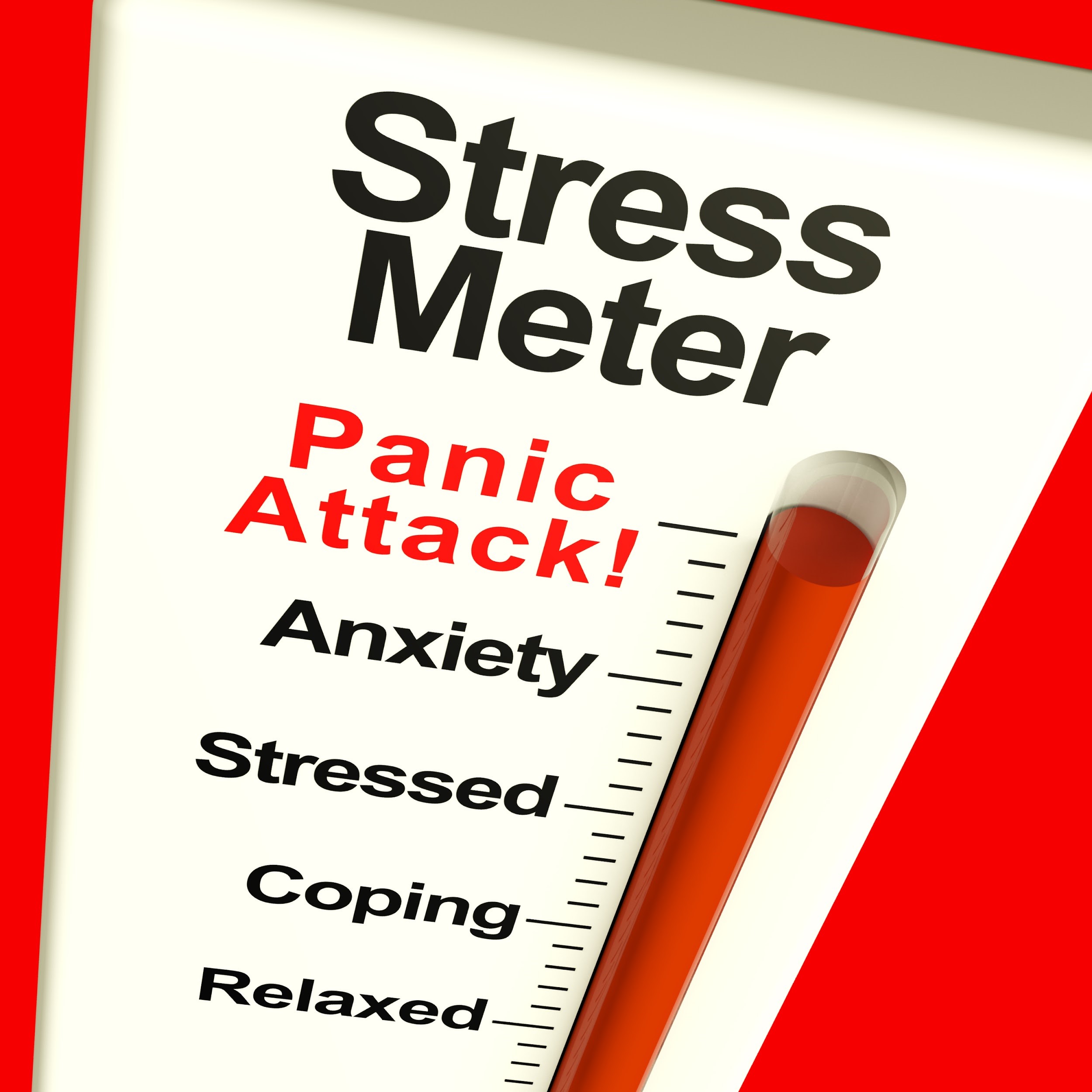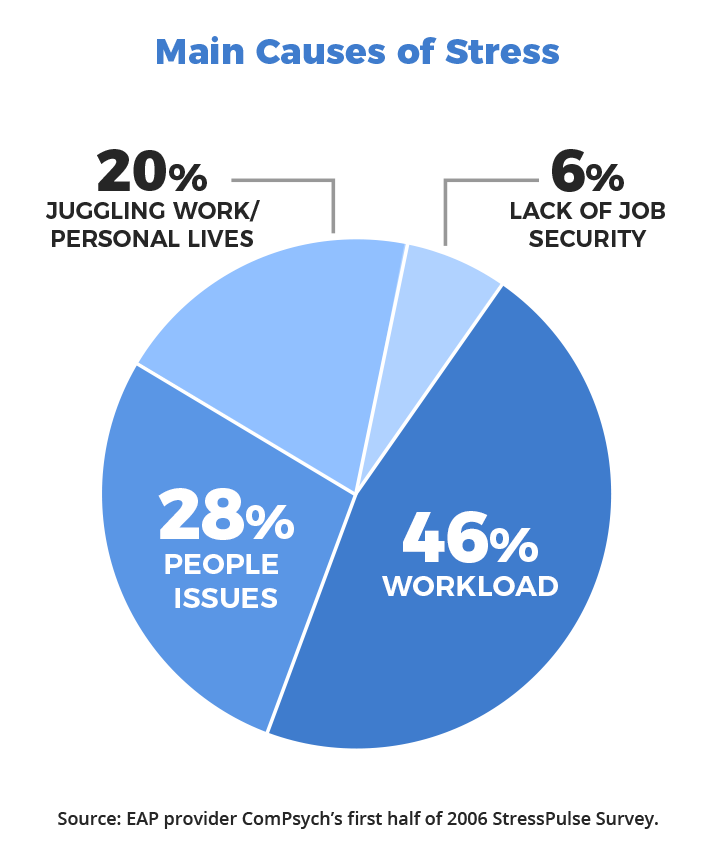The World Health Organization (WHO) has referred to stress as “the 21st Century epidemic”. About 33% of adults in the United States have reported feeling extreme stress and more than 70% stated that this affects them in both their physical and mental health. Let’s explore how to reduce stress at work.
According to The American Institute of Stress, the job, as well as issues related to the work environment, are the main causes of stress.
Stress is the body’s physical, mental and emotional reaction to adapt and respond to changes, whether they are positive or negative. People can experience stress from what happens day by day in their environment, in their bodies or even in their thoughts.
This reaction is generated by the autonomic nervous system of the human body, resulting in psychological changes that allow the person to be attentive, motivated and avoid danger. Known as “fight-or-flight”, this mechanism is an emergency physiological response that has the purpose of preparing the body for physical action (fight) or run away (flight).
However, when a person is constantly facing challenges without rest or the possibility of relaxing, this can turn negative, generating excessive tension.

Prolonged activation of the stress response can affect the body in both its physical and mental health. When it slips out of balance, it can turn into chronic anxiety and, in the worst case, lead to suicidal thoughts.
Anxiety is a normal emotion that can appear from time to time when facing a problem, a test, or before having to make an important decision. When the stress level is high, anxiety disorders may appear, which are included in the group of mental illnesses. They prevent the person from leading a normal life.
Anxiety disorders can be manifested as panic attacks when you feel you are about to die; social phobia, when you feel overwhelmed by everyday social situations; other phobias, and generalized anxiety disorder, when the person has exaggerated worry and tension for no apparent reason.
In addition to the mental effects, the activation of the fight-or-flight mode involves chemical changes in the body, which can alter the person’s metabolism. This can cause long-term effects, leading to diseases like diabetes or high blood pressure. Chronic stress can also cause other problems such as arthritis and inflammatory diseases.
The WHO has warned of the high levels of concern and unhappiness in today’s world that are causing an epidemic of stress. Stress has become part of people’s daily lives, affecting productivity and causing health problems, which at first may remain silent, but then they get worse.
If you feel anxiety, fear, sadness, frustration or anger, you could be suffering from stress, which could also be worsened by physical symptoms. In addition to emotional changes, stress can manifest itself through changes in your behavior and body.

When you’re stressed, you behave differently, such as being withdrawn, uncompromising, aggressive, or more angry than normal. You can experience sleeping problems, you can be irritable or tearful, and even see your sexual habits affected. Some people start smoking, consume more alcohol and even drugs. Stress can also affect the way you interact with your family and friends.
The body also suffers from symptoms such as headaches, nausea, and indigestion. You can increase the respiratory rate, perspire more than normal, feel palpitations or different types of aches and pains. If the stress motive wears off, you will return to normal quickly with no side effects, but if it persists, you could start having long-term effects.
If you are suffering from stress, you may be able to identify five stages:
1. Alarm: At this stage, the body prepares itself in the best possible way to deal with the stress you are going through. You can have wake-up calls like being about to have an accident or starting to forget tasks or deadlines.
2. Resistance: Here, the body tries to return to its normal state, responding to some changes that occur in the alarm stage, such as inflammation. Anti-inflammatory hormones are released to relieve it, but they are usually temporary responses that do not solve the underlying problem.
3. Recovery: If the cause of stress disappears or you are able to temporarily pull away from it, your body will begin to recover, returning your systems to normal levels and starting the stress resilience.
4. Adaptation: If you do not act in time to recover, either by moving away to rest or solving the problem that is causing you stress, you will enter the adaptation stage, which involves accepting it as part of your daily life. Stress becomes chronic and takes control of your health generating, for example, sleep problems, lack of energy, changes in your eating habits or difficulty in dealing with your emotions.
5. Exhaustion: With chronic stress, the body begins to get sick, nutrients are depleted, and you may require hospitalization, psychiatric assistance, or dealing with symptoms of depression.

When you reach the exhaustion stage, it occurs what is commonly called burnout. You feel overwhelmed, emotionally drained and unable to respond to any demand. It can lead you to lose interest and motivation, reduce productivity, and increase feelings like hopelessness, resentment, despair, and the feeling that you have nothing else to give.
Burnout can have very negative effects in all areas of your life, including your home, social life, health, and work. At work it might even cost your position, lead to being fired, or if you feel that the energy is low and you have nothing else to give of yourself, it can lead you to quit.
To deal with stress, some several techniques and strategies may be related to action (do something to change the situation), emotions (change your perception over a stressful situation) and acceptance (used when dealing with situations that you cannot control).
The following strategies summarizes everything that will help you to deal with stressful situations:
1. Be assertive: You need to communicate clearly what you want, what you need and explain what is bothering you. If you do it with empathy and respect but firmly, you will be proactive and start altering what is stressing you.
2. Reduce noise: Slow down by switching off technology, screen time and stimuli. Try to have quiet moments every day to distinguish the urgent and the important things. You need time to recharge to avoid stress.
3. Manage your time: Organize your tasks so you are not covered and busy the whole day. Create a routine that includes enjoying.
4. Creating boundaries: Set rules and establish time for yourself and the others. Prioritize and do not let the other’s needs be over yours. This will help to take control and respect yourself.
5. Stop thinking: Avoid doing too much analysis. Distract yourself and relax your mind.

To success with these strategies, you can implement techniques such as keeping a positive attitude, accepting situations that you cannot change, practice relaxation techniques like meditation or yoga, do exercise, make time for hobbies and interests, sleep and have a rest, avoid the use of alcohol or drugs, take time with your friends and family, look for professional assistance like a psychologist or a mental health doctors.
There are several studies that show that work is by far the biggest cause of stress among American adults and that this has grown a lot in recent decades. Research published by The American Institute of Stress reveals that 46% of the causes of stress come from work overload,
20% from juggling personal and work life, 6% from lack of job security, and the remaining 28% comes from other factors such as personal life.
Work-related stress appears as a response to demands and pressures that do not fit with the employee’s abilities or knowledge, challenging their ability to respond appropriately. Although it occurs in various situations, it is worse when they feel a lack of support from their supervisors and colleagues, and when they feel that they have no control over how to deal with demands or pressures.
The causes of work stress can be divided into two groups:

Work content: It has to do with work itself, and factors such as monotony, low stimuli or the assignment of insignificant tasks. It also includes the workload, which may be too much to accomplish in a given time. This is also influenced by a non-flexible schedule, bad shift design or unpredictability. Lack of control over work processes, pace, methods and the work environment can also generate stress.
Work context: It is about career development, status, salary, job insecurity, lack of promotion opportunities, unclear performance evaluation systems, or being over or under-skilled for a position in the organization. It also includes interpersonal relationships, when they are inappropriate or the employee does not have support, a bad relationship with colleagues, violence or workplace harassment. Organizational culture, communication, and poor also leadership appear in this group.

Ready to Reduce Workplace Stress?
Some symptoms that will tell if you are going through anxiety at workplace are physical and include pains, head and stomach aches, fatigue, eating and sleeping disorders. Other signs are cognitive and include for example, a difficulty to concentrate or make decisions, think or remember things. Finally, you may suffer from emotional symptoms such as feeling sad, tense or angry.
If you have detected some of the mentioned signs you may be suffering from work stress. Luckily, there are techniques and actions you can take to reduce it. The American Psychological Association proposes some:

Track your stressors: Keep a diary where you can identify what situations causing you stress, what you feel and how you react to them. This can help you find patterns in the causes and your reactions.
Develop healthy responses: Try to make healthy choices when you feel the tension grows. Some options are physical activity, time to hobbies, reading, going to concerts or playing with your family. Achieving good sleep quality also helps manage stress; try to limit caffeine and minimize stimulating activities at night.
Establish boundaries: Set schedules to carry out work tasks at home, such as limiting time for emails or moments to answer the phone.
Time to disconnect: To avoid burnout, it is important that you take rest and relaxation times to return to your pre-stress functioning levels.
Relax: Apply relaxation techniques, such as meditation, deep breathing or mindfulness.
Talk to your supervisor: If your health is good, you will improve productivity and therefore the company you work for will be benefited from promoting a healthy work environment. Try to have an open conversation with your supervisor to find a plan that allows you to manage the stressors that you have identified in your work and improve your performance. Detail those resources that you require, what is expected from you and what you need to change to make the space more comfortable.
Get support: Accept your friends and family support. Your employer may have an Employee Assistance Program (EAP) or information to help you too. If you continue to feel overwhelmed by work stress, consider talking to a psychologist.

Employers can often feel that their best employees are continually leaving them, and that may be related to your organization. HR experts have spotted some reasons why good employees quit their jobs.
Among them, the lack of confidence and autonomy, lack of appreciation or recognition, lack of respect, few or no opportunities for growth and development, feeling underutilized, having a bad manager who discharges frustrations and resentment over the team, poor
management, poor communication, excessive workload, lack of support, not finding a balance between work and personal life, lack of inspiration or unhealthy environment, seeing that the other good employees leave, lack of coincidence with the values of the company, and changes in their personal life.
Thus, feeling undervalued is among the main reasons for leaving jobs. You spend many hours at work, sharing time with your colleagues and of course, you want to feel comfortable. Nobody enjoys spending eight or ten hours a day in a place that make them feel unhappy. When you work hard and nobody notices it, or your ideas are not even considered, frustration and unhappiness levels increase.

You might feel lost on how to revert this situation without quitting, but some useful strategies will help you in this task. First, remember to talk to your boss or supervisor. You must prepare a plan to address the situation, so you have clear what to say. Never discuss when you are upset, but wait until you are quiet and think very well what you need to say.
Also, evaluate your efforts and have clear how you give value to the organization. Ask yourself if you work fast, or you have high standards, or if you are always ready to provide support. Maybe, you are doing everything expected but you need more feedback. Sometimes it is just not in the culture to provide feedback to employees with good results. If that the case, try to practice self-validation, or try to look for another position that requires higher engagement. In the same way, ask yourself if you are complimenting others and engaging enough with your coworkers.
Having understood the causes and consecuences, How can employers reduce stress at workplace? You can take some actions, starting with assuming positive leadership and staying calm in stressful situations.
It is important that you consult your employees about what factors can be stressful at work, and that you talk to them to reduce the uncertainty of their futures. Listening to them and having face-to-face meetings will make them feel heard and valued. Give them the opportunity to participate in the decisions that affect their work, make them feel involved.

You must deal with conflict by respecting the dignity of each employee and establishing zero tolerance for harassment and violence. Avoid unrealistic deadlines and make sure the tasks are right for each employee based on their abilities and resources. Make your expectations clear, define roles, responsibilities, and goals for each other. Above all, make sure that management’s actions are aligned with the values that you proclaim.
Offering awards and incentives, recognizing achievements and planning potentially stressful work periods are also actions that help reduce stress, as well as promote social interaction between employees.
Motivation will make your employees feel more like working and see that their effort makes sense, both for the company and for their personal and professional growth. It is your responsibility to create the right space for your team that makes them feel comfortable and motivated to continue working.
For this, some effective ways to motivate your team are proposing games and incentives, offering rewards for meeting goals, letting them know that you trust them and that your level of trust depends on them, their work and attitude. Employ personal incentives, not just for teams.
Setting weekly short goals is another way to maintain enthusiasm and motivation, rather than generating long-term objectives that may lead to the loss of interest. It is also important that you give them a purpose within the organization and a role in fulfilling that purpose.
Radiate positivity to spread enthusiasm and be transparent with your employees to avoid surprises, allowing everyone to ask and know what is happening, as well as give their feedback. Let different team members lead the meetings; That will make them feel connected and focused.
When addressing to your team, there are some things that you can always say to motivate them. The first one is “Thank you”, as a way to show gratitude and make them feel that each of them is important. Remember to thank them regularly, or after finishing a big project. It can be very meaningful.
Also, ask for their opinion. You as the boss or manager can rely on your team opinion and that makes them feel valued. This, will not only motivate them, but also will help to expand your knowledge and perspective.
When someone shares a good idea, remember to recognize it. “That is great!!” may sound careless to you, but your team members can feel satisfied, positive and willing to think more great ideas. It is also contagious and the rest of the team may feel like participating too. In the same line, you need to cheer them up and encourage them, filling them with confidence to face further challenges.
Do not forget to offer help. You want to be a leader more than a boss. Giving

support and providing resources will make them feel that they are not alone and they do not have to deal with everything on their own. They can trust you.
Replace the “we” for the “I” to make them feel that this is a team and everyone works together. You are the leader and member of the group.
As a manager, it is very hard to motivate your team if you are not motivated yourself. But not always the organizations have what programs or incentives to do it. If you are dealing with this kind of issues, there are some strategies that you can follow for self-motivation.
First, you need to know that not every days are going to be excellent, or even good. It is ok to have a bad day and you do not have to be frustrated by that. Don’t be rude with yourself, but accept your feelings and think that tomorrow it will be better. Try to look for support of your family and friends.
Avoid telling yourself what you cannot do, and all kind of negative thoughts. If you are telling yourself bad things, your brain will believe it. Trust yourself. Also, when you have problems, try to switch the way you look at them. Always, you can find an opportunity within a problem, but you have to be open to see it.

Don’t spend time criticizing others such as colleagues, politicians or the context itself. It is better to keep positive and think how you would like to be or what you wish it happen. Another tip is to get help when you need it. Find someone who has different skills than you do, so you can address the task in another way.
Set short deadlines and short term goals, so you can reach the objectives and feel that you are going on. Finally make your own SWOT analysis. Think on your Strengths, Weaknesses, Opportunities and Threats, and try to define where you are standing now.
For help dealing with workplace stress in your organization or business, call The Resiliency Solution at 919-525-4559.